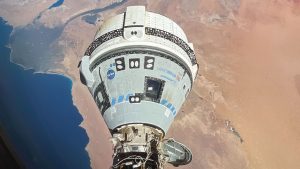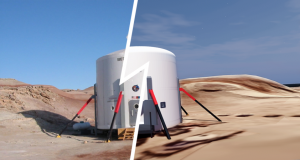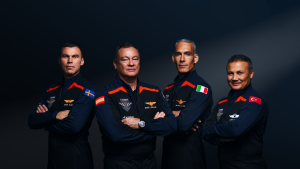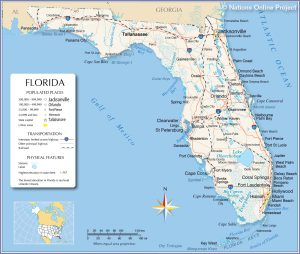International Day of Human Space Flight
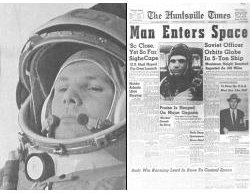
The U.N. General Assembly has declared April 12th the International Day of Human Space Flight. Why this day? Well, on April 12, 1961, a Russian cosmonaut named Yuri Gagarin was launched on a single orbit around Earth. It was an important breakthrough and one in a series of Space Race firsts on the Russian side. Manned space flight has been the catalyst of many scientific breakthroughs since then and continues to capture the imagination of people around the world.
Yuri Gagarin Makes History
First Space Flights
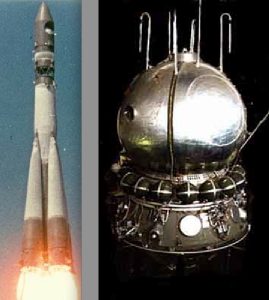
- April 12, 1961: Yuri Gagarin’s Flight. The Soviet Union stuns the world with the 108-minute, one-orbit Vostok 1. This is Yuri Gagarin’s first and only space flight.
- May 5, 1961: Freedom 7. Alan Shepard becomes the first American in space. His Mercury capsule, named Freedom 7, carried him through a 15-minute subobital flight.
- July 21, 1961: Liberty Bell 7. Crewed by Gus Grissom, the Liberty Bell 7 confirms the success of Freedom 7. His capsule sinks and is recovered in 1999.
- August 6, 1961: Vostok 2. Cosmonaut Gherman Titov vastly surpasses any manned space flight to date with 17 orbits. He briefly took manual control of his spacecraft. This is also the first documented case of space adaptation syndrome, better known as “space sickness”. Titov still holds the record for the youngest star voyager, having been just one month shy of 26 years old at the time of his flight.
- February 20th, 1962: Friendship 7. Astronaut John Glenn becomes a space legend as the first American to orbit the Earth. His flight lasts three orbits. A false signal of a faulty heat shield adds drama to his flight.
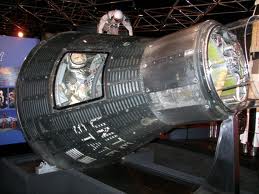
- May 24, 1962: Aurora 7. Astronaut Scott Carpenter becomes the second American to orbit Earth. His flight also lasts three orbits. Carpenter studies phenomena such as the action of fluids in weightlessness and Earth photography. He comes down 250 miles off course.
- August 11-15, 1962: Vostok 3. Cosmonaut Andrian Nikolayev sets a new duration record with a 4-day, 64-orbit mission. One goal was to study the “space sickness” phenomenon noted in the previous Vostok mission and, along with Vostok 4, individual response to weightlessness.
- August 12-15, 1962: Vostok 4. Cosmonaut Pavel Popovich made 48 orbits. This marked the first time any nation had two concurrent spaceflights. This was meant to test the ability to control multiple spaceflights. The two Vostoks passed within 6.5 kilometers of each other and Popovich later reported that Vostok 3 looked like a small moon. Though many newspapers reported it as the first space rendezvous, the two spacecraft never flew in formation.
- October 3, 1962: Sigma 7. Wally Schirra doubled the American duration record with a 6-orbit, 9-hour flight. It tested a control technique meant to conserve fuel. The flight plan emphasized engineering tests in preparation for longer duration flights; hence the engineering-derived name Sigma 7.
- May 15-16, 1963: Faith 7. Astronaut Gordon Cooper becomes the first American to spend a full day in orbit. Faith 7 completes 22 orbits in 34 hours and confirms the value of having a man on board a spacecraft. Most of the onboard electrical systems fail, forcing him to make a manual reentry. It is the first American space flight to feature multiple shifts in the Mission Control Center, with Flight Director Chris Kraft leading his Red Team and John Hodge leading his Blue Team.
- June 14-19 1963: Vostok 5. Cosmonaut Valery Bykovsky makes 82 orbits in almost 5 days, which remains a record for solo space flight. It was originally intended to last 8 days but was cut short due to solar activity.
- June 16-19, 1963: Vostok 6. Cosmonaut Valentina Tereshkova becomes the first woman in space and the only woman to make a solo space flight. She is also the first civilian to make a space flight. Science projects included photography that revealed an aerosol layer in the atmosphere. This is the last flight of a Vostok as the Russian space program gears up for the Voskhod program.

- July 19, 1963: X-15 Flight 90. Crewed by test pilot Joseph A. Walker, this becomes the first spaceflight made by one of the experimental X-planes. The suborbital flight reaches an altitude of 106.01 kilometers. Walker becomes the first American civilian in space.
- August 22, 1963: X-15 Flight 91. Also crewed by Joseph A. Walker, this flight made him the first person to go into space twice. It reached an altitude of 107.96 kilometers. It was the last X-15 flight to go over 100 kilometers.
The Space Race Continues

- October 12-13, 1964: Voskhod 1. This would be the only space flight for either the Soviets or the U.S. for 1964. It was the first flight with more than one crew member, with Cosmonauts Vladimir Komarov, Konstantin Feotistov, and Boris Yegorov on board. The Voskhod was designed for two crew members. By eliminating spacesuits, the Russian space program was able to squeeze three cosmonauts on board. It set an altitude record of 336 kilometers.
- March 18-19, 1965: Voskhod 2. Cosmonauts Pavel Belyayev and Alexei Leonov wore spacesuits for this flight. Leonov exited the Voskhod through an inflatable airlock for the world’s first spacewalk that lasted 12 minutes. His spacesuit expanded and stiffened to the point that he had to let out a little air to make it back through the airlock. The crew then had difficulties closing the airlock and made a manual landing when their automatic control system failed.
- March 23, 1965: Gemini 3. Gus Grissom and John Young crewed this first manned flight of the Gemini program. Tests included a shakedown of the maneuvering system in which the crew shifted their orbital plane, changed the shape of their orbit and dropped to a lower altitude. Highlights of the flight included a contraband corned beef sandwich and Gus Grissom’s name of “Molly Brown,” a name that proved unpopular with NASA’s Public Relations staff. This would be the last named American spacecraft until the Apollo Program began testing the Lunar Module.
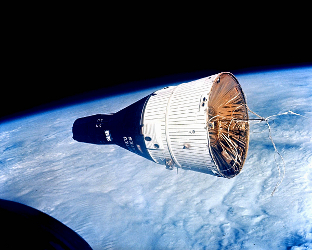
- June 3-7, 1965: Gemini 4. James McDivitt and Edward White set a new American duration record at 4 days. It also included America’s first spacewalk by Ed White. Tethered to the Gemini with only a cord that provided air, he floated free for 20 minutes. Other tests included a sextant meant for stellar navigation. A rendezvous with their booster rocket failed due to a miscalculation on the ground.
- August 21-29, 1965: Gemini 5. Gordon Cooper and Charles “Pete” Conrad set a new world duration record of 7 days, 21 hours and 55 seconds. Objectives included testing man’s ability to endure weightlessness for the duration of a minimal Moon mission. It also tested new fuel cells to provide power. The fuel cells suffered a failure early in the flight, limiting crew activities, though they still came close enough to making their goal of “Eight Days or Bust.”
- December 4-18, 1965: Gemini 7. Frank Borman and James Lovell shattered the previous record for a duration record of 13 2/3 days, an American record that would stand until Skylab. Tests included a new spacesuit design that became uncomfortable in cramped conditions and nutritional needs during a long-duration flight.
- December 15-16, 1965: Gemini 6A. Were you paying attention? Gemini 7 began before Gemini 6A! Crewed by Wally Schirra and Thomas Stafford, Gemini 6 was riddled with problems, such as an exploding Agena and a failed launch. The mission was changed to a rendezvous with Gemini 7. This would be the first true rendezvous in space. Rendezvous maneuvers brought them to within 40 meters of Gemini 7. Additional maneuvers brought the two Geminis as close as 30 centimeters apart, close enough for the two crews to get a good look at each other. Other highlights included the first report of a UFO in space. Gemini 6 reported a satellite in polar orbit and resembled a large command module towed by eight smaller modules. It was apparently crewed by a man in a red suit. This was followed by the first live song played in outer space. Wally Schirra played Jingle Bells on harmonica with Stafford accompanying on bells.
- March 16-17, 1966: Gemini 8. Crewed by Neil Armstrong and Dave Scott, Gemini 8 began a year in which the Soviets were quiet on the space front. Goals included rendezvous and docking with an Agena, an automated spacecraft, as well as an EVA by Dave Scott. Rendezvous and docking went smoothly, and then a stuck thruster caused Gemini 8 to spin out of control. Thinking it was a problem with the Agena, Armstrong undocked and had to use the reentry system to stabilize the Gemini. This canceled the EVA along with the rest of the mission and they made an early reentry.
- June 3-6, 1966: Gemini 9A. Astronauts Thomas Stafford and Eugene Cernan moved up to prime crew after the deaths of Elliot See and Charles Bassett in an airplane accident. Mission highlights included the second EVA by an American crew. The Gemini successfully rendezvoused with an automated spacecraft called the Augmented Target Docking Adopter (ATDA) but were unable to dock due to a malfunction in the shroud that made it unable to separate from the ATDA. Stafford reported that the stuck shroud made it look like an “angry alligator.” During the EVA, Cernan was to exit the spacecraft and then work his way back to an Astronaut Maneuvering Unit developed by the Air Force. It proved more difficult than expected and Cernan exhausted himself in the effort. He was forced to quit and the idea of an Astronaut Maneuvering Unit was abandoned until after Apollo.
- July 18-21, 1966: Gemini 10. Crewed by John Young and Michael Collins, this mission featured two EVAs by Michael Collins and rendezvous with two automated spacecraft, with one docking. After burning more fuel than expected while performing rendezvous maneuvers, they docked with the first Agena and used its engines to boost them to an altitude record of 763 kilometers. This proved that it was possible for a manned spacecraft to safely pass through the radiation belts surrounding Earth. Collins’ first EVA was a simple “stand-up” EVA in which he took pictures of some stars with an ultraviolet camera. Then, they rendezvoused with Gemini 8’s Agena. During the second spacewalk, Collins used a propellant gun similar to the one White had used for his Gemini 4 spacewalk to propel himself over to the Agena. At one point, his maneuvering put him close to one of the Gemini’s engines. Young had to periodically fire the engines for station-keeping and Collins warned him, “John, do not fire that engine!” Arriving at the Agena, Collins could not get a grip on its surface and had to grab some wire bundles to steady himself. He retrieved a micrometeroid collector from the Agena and returned to the Gemini. Upon returning, he discovered that he had lost the camera with his ultraviolet pictures.
- September 12-15, 1966: Gemini 11. Crewed by Pete Conrad and Richard “Dick” Gordon, Gemini 11 performed the first direct-ascent rendezvous. This meant a rendezvous of one orbit or less, believed to be a critical test for the Apollo Project. It included an altitude record of 1,370 kilometers, tests that produced a small amount of artificial gravity and two spacewalks by Gordon. During the first spacewalk, Gordon attached a tether in the Agena’s docking ring to the Gemini for a stabilization experiment, another tiring task that forced him to cut the EVA short. The stabilization experiment did not work as planned, as the tether would not stay tight. The second EVA was a simple stand-up in which Gordon took pictures of Earth, clouds and stars.
- November 11-15, 1966: Gemini 12. James Lovell and Buzz Aldrin crewed the final mission of the Gemini Project. It featured one rendezvous and docking and a record three spacewalks by Aldrin. Improvements in training had helped Aldrin prepare for the spacewalks and handholds had been added to the outside of the Gemini. For the first spacewalk, Aldrin photographed star fields, retrieved a micrometeroid collector from the Agena and finally demonstrated the feasibility of EVA. The other two EVAs, meant strictly for photography, went equally smoothly. The patch symbolized the fact that Gemini 12 was the last step before Apollo and the ultimate push to the moon.
Apollo 1
January 27, 1967: Apollo 1. The world receives a harsh reminder of the hazards of space flight when Gus Grissom, Ed White and Roger Chaffee are killed in a fire during what should have been a low-risk ground test of the Apollo Block 1 spacecraft. This effectively calls a halt to the American manned space program for 1967 and most of 1968 while NASA pursues an investigation and makes improvements to the Apollo spacecraft and procedures.
The Final Push to the Moon
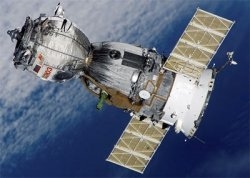
- April 23-24, 1967: Soyuz 1. Crewed by Vladimir Komarov, Soyuz 1 is the first manned flight of the Soyuz series. It was launched despite fears of flaws in the spacecraft and previous unmanned tests that failed. Due to on-board malfunctions and a parachute that failed to deploy, the Soyuz plowed into the landscape at high speeds after reentry, killing Komarov. This would also put a halt to the Soviet space program for more than a year.
- October 11-22, 1968: Apollo 7. Crewed by Wally Schirra, Donn Eisele and Walter Cunningham, Apollo 7 was the first manned Apollo flight. Goals included a shakedown of the maneuvering system. This flight is remembered best for being the first flight in which the entire crew reported having caught colds and an uncharacteristically grouchy Wally Schirra who tested the limits of ground controllers’ patience. It was Schirra’s final flight for the American space program and the only space flight for Donn Eisele and Walter Cunningham.
- October 26-30, 1968: Soyuz 3. The Soviets’ own “Return to Flight” mission was crewed by Georgy Beregovoi. He successfully rendezvoused with the unmanned Soyuz 2. Beregovoi took some Earth photography and also transmitted the first “live” tour of his spacecraft. When the Soviet Union disintegrated, it was revealed that docking was one of the goals, but this had failed.
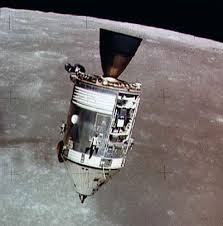
- December 21-27, 1968: Apollo 8. Frank Borman, James Lovell and William Anders became the first people to orbit the Moon in this mission. This would be the first mission to leave the Earth orbit they were used to and some of the ground team were nervous about rendezvousing with a large object more than 200,000 miles away. A mistake could either leave them lost in space, or crash them into the lunar surface. The mission was a success. Apollo 8 orbited the moon 10 times and brought back the famous “Earthrise” photo.
- January 14-18, 1969: Soyuz 4/5. The goals of Soyuz 4/5 was rendezvous, docking and transfer of crewmen. Vladimir Shatalov launched alone on Soyuz 4. Boris Volynov, Aleksei Yeliseyev and Yevgeny Khrunov launched on Soyuz 5 a day later. Yeliseyev and Khronov transferred to Soyuz 4 in an EVA, carrying along newspapers printed after the launch of Soyuz 4 to prove that the transfer took place.
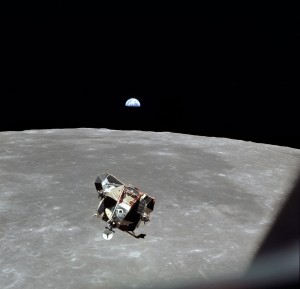
- March 3-13, 1969: Apollo 9. Crewed by Jim McDivitt, Dave Scott and Rusty Schweickart, Apollo 9 featured tests of the Lunar Module while in Earth orbit. To avoid confusion in communications with the ground, the call signs of “Gumdrop” for the command module and “Spider” for the lunar module were selected. Planned EVA activities were scaled back when Schweickart suffered space sickness severe enough to weaken him. Spider’s separation, independent flight and docking maneuvers were successful.
- May 18-26, 1969: Apollo 10. Crewed by Thomas Stafford, John Young and Gene Cernan, Apollo 10 tested the lunar module in lunar orbit. They chose “Charlie Brown” for the command module and “Snoopy” for the lunar module. They set a speed record at 39,897 km/h and a distance record at 408,950 kilometers from their home in Houston. (The Moon’s orbit is not perfectly circular and Earth’s rotation provided the extra distance between Houston and the Moon.) Snoopy’s flight path brought it to within five miles of the intended first lunar landing site. A faulty setting in the lunar module caused some wild gyrations during the return to the command module.
The First Moonwalk
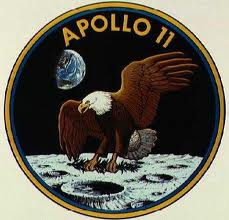
July 16-24, 1969: Apollo 11. America becomes the first nation to land men on the Moon and bring them home safely. Neil Armstrong, Buzz Aldrin and Michael Collins fly into history with Eagle as the Lunar Module and Columbia as the command module. The world pauses to watch as computer errors and a rocky landing site cause excitement. Neil Armstrong takes manual control of the Eagle to find a better landing site. Too excited to sleep, they prepare for the first lunar EVA and Neil Armstrong takes his first step on the lunar surface: “That’s one small step for man, one giant leap for mankind.” Buzz Aldrin follows with, “Beautiful, beautiful, magnificent desolation.” Collins remains in orbit and tries to spot them in their new landing site, but never sees them. On the way back, they reflect on the symbolic meaning of their historic mission and come home to a few weeks in quarantine, and then go on a whirlwind world tour.
Post-Apollo 11 Space Flights
- October 11-18, 1969: Soyuz 6/7/8. This is the first attempt to rendezvous three spacecraft. On Soyuz 6, Georgi Shonin and Valeri Kubasov test welding techniques in orbit. On Soyuz 7, Anatoly Filipchenko, Vladislav Volkov and Viktor Gorbatko planned to be the active element in docking maneuvers between the three spacecraft. On Soyuz 8, Vladimir Shatalov and Aleksei Yeliseyev would have been the passive element in docking maneuvers. The rendezvous failed due to equipment failures. The Soviets claimed that no docking was intended but tangible evidence suggest otherwise.
- November 14-24, 1969: Apollo 12. Crewed by Pete Conrad, Richard Gordon and Alan Bean, Apollo 12 was the second lunar landing. This mission included two lunar EVAs and a more accurate lunar landing. During launch, Apollo 12 was struck by multiple bolts of lightning, causing a temporary power outage. The mission could have been aborted, but EECOM John Aaron in the Control Center remembered seeing something like this before. “Try SCE to Aux.” Conrad didn’t know what he meant but, fortunately, Bean did and hit the switch. The Apollo 12 brought back samples from the lunar probe Surveyor 3 along with 34.35 kilograms of rock and soil samples and many pictures taken on the surface and in orbit.
- April 11-17, 1970: Apollo 13. Crewed by James Lovell, Jack Swigert and Fred Haise, this is the mission that never landed on the moon. An oxygen tank exploded, causing damage to several critical systems in the service module. The lunar module became a lifeboat for the crew and the ground spent several intense days fighting to bring them home. The mission was called a “successful failure” and led to a redesign to components in the service module.
- June 1-19, 1970: Soyuz 9. Crewed by Andrian Nikolayev and Vitaly Sevastyanov, the crew conducted biomedical experiments and also tested the social aspect of space flight. Features include the first documented chess game played between cosmonauts in orbit and controllers on the ground, the first World Cup soccer game watched from space, and the first time that space voyagers cast a vote from space. It set a new endurance record and marked a shift in focus to tests of a crew’s ability to live long-term in space.
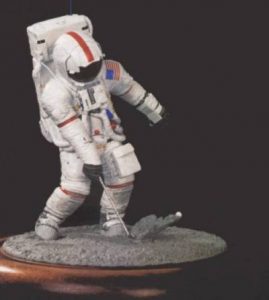
- January 31-Febuary 9, 1971: Apollo 14. Alan Shepard, Stuart Roosa and Edgar Mitchell successfully reached the landing site in Fra Mauro that Apollo 13 would have explored. It included the use of a handcart-like device for transporting materials. They attempted to reach the summit of the nearby Cone Crater, but their exertions caused concern on the ground and they stopped just 65 feet from the summit. This mission is best known for Alan Shepard’s lunar golf shot and Mitchell’s informal experiments in ESP phenomena. Mitchell also threw a lunar scoop handle like a javelin while on the moon. Roosa conducted several experiments, took lunar photographs while in orbit and also had several tree seeds that were later germinated as the “Moon trees.”
- April 23-25, 1971: Soyuz 10. Having lost the race to the Moon, the Soviets shifted their attention to a series of space stations known as Salyut. Crewed by Vladimir Shatalov, Aleksei Yeliseyev and Nikolai Rukavishnikov, this was Russia’s first attempt to dock with the world’s first space station, Salyut 1. They rendezvoused with Salyut 1 but failed to dock and were forced to return home.
- June 6-30, 1971: Soyuz 11. Georgi Dobrovolski, Vladislav Volkov and Viktor Patsayev became the first crew to occupy the Soviet space station Salyut. Their mission lasted 23 days, a new duration record. They died during reentry when their capsule depressurized. This would cause concern on the American side because NASA was heavily into planning for the Skylab space station.
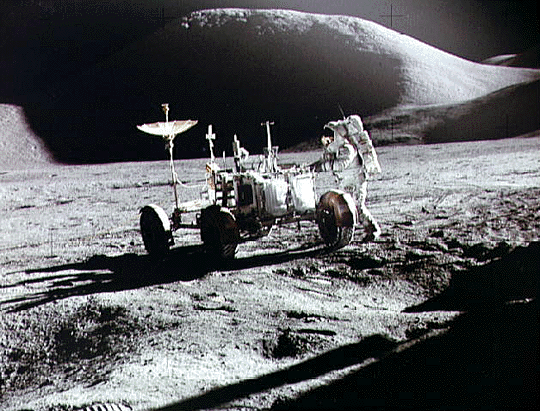
- July 26-August 7, 1971: Apollo 15. David Scott, Al Worden and James Irwin were an all-Air Force crew and the first to drive the Lunar Rover. It featured three lunar EVAs and the first deep space spacewalk made by Al Worden. It also marked the first documented heart attack during a space mission and James Irwin would eventually succumb to heart trouble. Their mission was a huge success but was marred by a scandal in which the astronauts had carried unauthorized postal covers for a company to sell later. It would end the astronaut careers of all three men.
- April 16-27, 1972: Apollo 16. Crewed by John Young, Charles Duke and Ken Mattingly, Apollo 16 explored the lunar Descartes Highlands. Scientists hoped that they would bring back volcanic material but the crew found none. They made three lunar EVAs over three days, driving the second lunar rover. One of the experiments was damaged when Young tripped over a cable. Before returning to Earth, Apollo 16 released a satellite that would continue studying the moon.
- December 7-19, 1972: Apollo 17. Crewed by Gene Cernan, Ronald Evans and Harrison Scmitt, this was the last of the Apollo moon missions. Scientists fought to have a geologist on board, which led to Scmitt’s assignment as a scientist-astronaut. The crew made three lunar EVAs and drove the Lunar Rover a record 35.9 kilometers. They left behind a plaque commemorating Apollo’s achievements.
Lunar Grand Prix
The Apollo 16 crew takes the lunar rover out for a drive, including a speed test that became popularized as the first lunar Grand Prix.
Skylab: America’s First Space Station
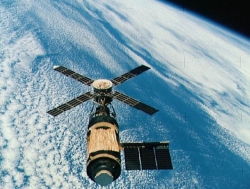
Skylab was America’s record-setting space station, which set records for longest mission duration (84 days), longest spacewalk (7 hours 1 minute), first comet observed from orbit, and first solar flare observed from orbit. It was mainly constructed using parts left over from the Apollo Program and hosted three crews. It was considered a huge success for its time and added a considerable amount of knowledge about living and working in a space environment. Learn more about Skylab here
An Educational Documentary about Skylab
Apollo-Soyuz Test Project

Deke Slayton had been fighting for a space flight for years. He had been yanked from his Mercury flight and grounded because of a minor heart condition and was finally able to convince doctors to clear him for space flight. Unfortunately, it was too late for him to make an Apollo moon mission or even Skylab. He still had one option with the Apollo-Soyuz Test Project, which was the first international mission between the Soviets and the Americans. Fellow crewmates included Thomas Stafford and Vance Brand on the American side and Alexei Leonov and Valery Kubasov on the Russian side.
Notable firsts included the first American visit to Russia’s “Star City,” home to Russia’s cosmonauts, the first docking between an American and a Russian spacecraft, and the first recorded international “gotcha” in space. One of the Russian cosmonauts gave Slayton a pack of what he claimed was vodka. When Slayton tasted it, the contents turned out to be borscht. At the time, diplomats hoped that this would lead to more joint space missions, but relations between the two superpowers cooled soon afterwards. This put a halt to more joint space operations until the Shuttle-Mir and International Space Station programs.




